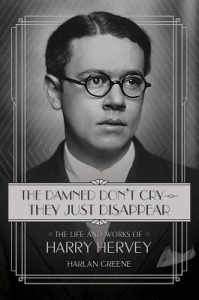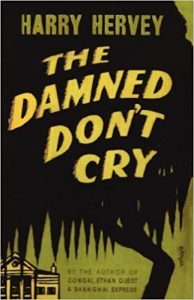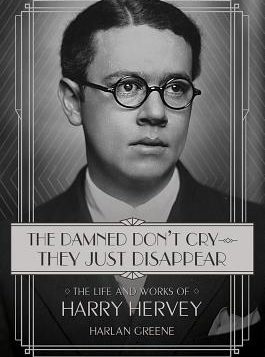 The Damned Don’t Cry, They Just Disappear: The Life and Works of Harry Hervey
The Damned Don’t Cry, They Just Disappear: The Life and Works of Harry Hervey
by Harlan Greene
University of South Carolina Press. 184 pages. $29.99
IN 1993, John Berendt’s Midnight in the Garden of Good and Evil, a nonfiction bestseller, detailed the dark underside of Savannah, Georgia. As it turns out, nearly fifty years earlier, a writer named Harry Hervey had published a novel called The Damned Don’t Cry that was also about the seamy side of life in that city. Hervey’s works are largely forgotten today despite being bestsellers when they first came out. What’s more, a closer inspection reveals that his fiction and screenplays dealt with gay themes to a surprising degree, and that he lived a daringly open life as a gay man with his lover, despite the strictures of the time. [A feature piece on Hervey appeared in these pages in the May-June 2017 issue.]
Harlan Greene, the author of this painstaking act of literary excavation, became aware of Hervey decades ago, but there seemed to be no information available about him. Yet, in the early 1930s, Hervey was well enough known as to land a job in Hollywood, where he soon adapted his own short story for the Marlene Dietrich classic film, Shanghai Express (1932).
What’s perhaps most interesting about Hervey is the amount of gay material he was able to slip into his work, apparently undetected. In the early novel Ethan Quest, the main character is given the gift of a sarong on a trip undertaken early in his life. The sarong becomes an emblem of his artistic difference. Later, when he meets a handsome native boy in Hawaii, he winds up ditching  his wife in favor of a strong friendship with the boy, thereby embracing the lifestyle of the “gay sarong.’” Here the symbolism and subtext become, at least for modern readers, painfully obvious. Greene is very astute in finding such coded nods to a gay readership. One of Hervey’s characters meets a close, lifelong male friend in a French pissoir, for instance. He is also persuasive in pointing out that, while contemporary readers may find his portrayals of man-eating women misogynistic, utilizing such females allowed Hervey to write about relationships and attractions for men in a much freer way. As Greene puts it: “[Thi-Lin] is also his mouthpiece for his utter joy and hunger and appreciation of the male body.”
his wife in favor of a strong friendship with the boy, thereby embracing the lifestyle of the “gay sarong.’” Here the symbolism and subtext become, at least for modern readers, painfully obvious. Greene is very astute in finding such coded nods to a gay readership. One of Hervey’s characters meets a close, lifelong male friend in a French pissoir, for instance. He is also persuasive in pointing out that, while contemporary readers may find his portrayals of man-eating women misogynistic, utilizing such females allowed Hervey to write about relationships and attractions for men in a much freer way. As Greene puts it: “[Thi-Lin] is also his mouthpiece for his utter joy and hunger and appreciation of the male body.”
Hervey’s content is not all covert, however. One of his plays (which was ultimately never staged, as it was illegal to depict gay people or to discuss homosexuality in the theater) dealt with the subject of opportunistic sex between male prisoners. In it, one of the characters remarks wittily: “Necessity is the mother of inversion.” In other works, Greene perceptively points out: “Hervey subversively and subtly turns the ‘normal’ love story on its head, making the homoerotic attraction between the men a healthier alternative than the lust between a man and a woman. … Male bonding triumphs over heterosexual lust, an astonishing turn of events for a novel of the day.”
Greene finds it perplexing that Hervey’s work has never been included in any survey of groundbreaking gay writers. Even today, it is difficult to assess Hervey’s work accurately because so much of it is out of print. This is the first comprehensive biography of him ever to appear. It is also hard to gauge the quality of Hervey’s writing: the snippets included seem bombastic and overwrought. That said, he is certainly—especially in Greene’s meticulous recreation—a very interesting figure. Other reasons for his obscurity may be that The Damned Don’t Cry is an unflattering portrait of Savannah, and Savannah appears to have returned the favor by trying to bury all memory of him. Then, too, Hervey’s insistence on living his life openly as a gay man with a male partner may have contributed to his ostracism.
What is apparent, though, is that Hervey was particularly courageous and daring in trying to carve out a lifetime of happiness for himself in a very unforgiving period, pushing boundaries wherever he could. Hervey died broke and forgotten in 1951. Perhaps this excellent biography will help to restore his place in literary history.
________________________________________________________
Dale Boyer’s most recent work of fiction is Thornton Stories.






